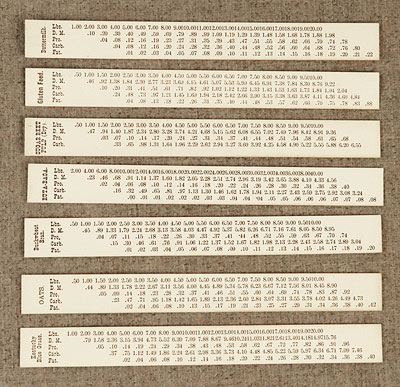 Up
Up
|
|

|

|
The Jeffers Calculator |
|
|
|
|
|
|
The Jeffers calculator is one of those unique
devices that stand alone in a corner of calculation space, making
them all the more delightful for the collector lucky enough to run
into them. Invented in 1907 by one Henry W. Jeffers, this unusual contraption lets the farmer calculate -- and optimize -- the nutritional value of animal feed mixtures. |
|
|
|
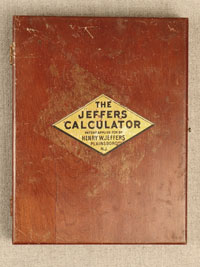
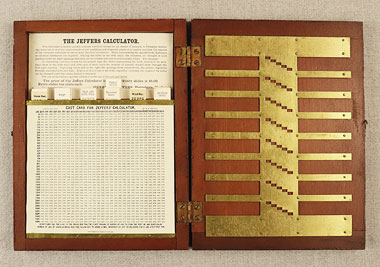 Click a photo to enlarge |
|
|
|
The calculator consists of a two hinged wooden plates (21.3x16.4 cm each) that can close like a book. The right hand plate bears an intricate brass plate with eight channels (called “slide ways” in the instructions) and multiple cutouts (“sight openings”). The other plate is mainly used to store 68 cardboard “slides”, each dedicated to a single feed ingredient, such as wheat, oats, cow pea hay, dark feeding flour, cottonseed hulls, buckwheat middlings, corn bran, and other edible feeds (some of which I’ve never heard of, but which farm animals hopefully consider yummy). |
|
|
|
You pick the slides corresponding to the feed ingredients you want to mix, and slide them into the slide ways. Then you move each slide right and left until the weight you want to use for each ingredient shows in the leftmost cutout. The next four cutouts will now show the weight of dry matter, digestible proteids, carbohydrates and fats in that amount of the ingredient. Since the cutouts for each nutrient are lined up vertically, it is an easy matter to add the numbers and see the total nutrient composition of the entire mixture. An example is shown in the following photo, where four pounds of barley, two pounds of buckwheat shorts, and seven pounds of whey are to be mixed, yielding a total of 5.80 lbs dry matter, 0.83 lbs proteids, 3.62 lbs carbohydrates and 0.19 lbs fat. |
|
|
|
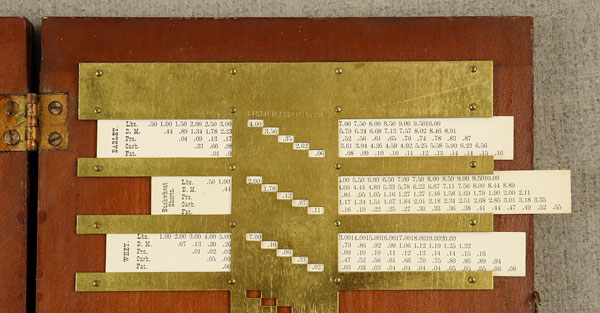 Click photo to enlarge |
|
|
|
The calculator comes with clear instructions in the left pane: |
|
|
|
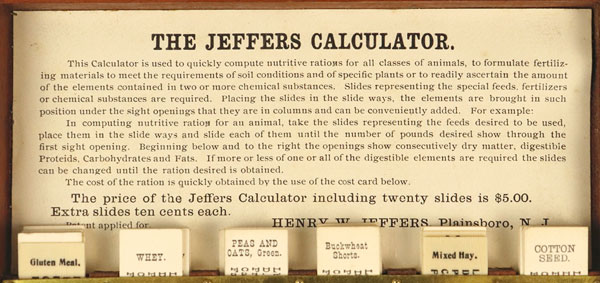 Click photo to enlarge |
|
|
|
An additional feature of this device is the “Cost card”, a table provided under the instructions. This is essentially a large multiplication table that allows you to figure the price of X pounds of some material at Y dollars per ton. Interestingly, the text and numbers in the table are reproduced from a handwritten master, not a printed one like the cards and the instructions. |
|
|
|
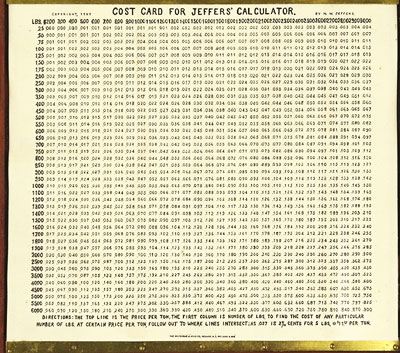 Click photo to enlarge |
|
|
|
The inventor of this useful calculator, Henry Williams Jeffers (1871–1953), was a man of many achievements, which earned him his own Wikipedia entry. There we learn that he was a dairyman and Republican politician from New Jersey, and that he invented a number of technological innovations streamlining dairy production, including the Jeffers bacteriology counter, the calculator discussed here, and the Rotolactor rotary milking parlor -- where 50 cows are carried around on a revolving platform like components on an assembly line! |
|
|
|
Exhibit provenance: eBay, from an American seller. More info: |
|
|
|
|
|
|
|
Home | HOC | Fractals | Miscellany | About | Contact Copyright © 2022 N. Zeldes. All rights reserved. |
|
